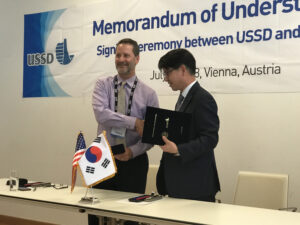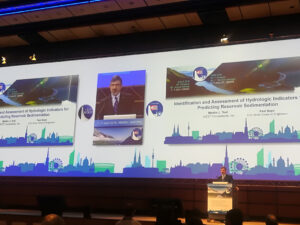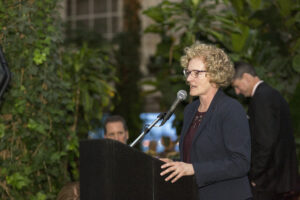During the first half of 2020, the hydropower industry has been subject to major regulatory changes that are likely to have far-reaching and significant consequences for licensees, regulators, and other stakeholders. These changes include two major rules altering longstanding regulations pertaining to the Clean Water Act (CWA) and the National Environmental Policy Act (NEPA); proposed changes to the Federal Energy Regulatory Commission’s (FERC) dam safety program following the catastrophic dam failures in Michigan; and several key pieces of proposed legislation working their way through Congress.
Hydro Leader: Please tell us about your background and your current position.
Sharon Powers: I’ve been a nonprofit professional for over 25 years, spending most of that time in C-suite positions in chambers of commerce. Before joining USSD, I was a department director at the American Water Works Association. While I spent my childhood in Pittsburgh, my father was from Denver. I always knew that I wanted to get back to Denver, which I did a little over 10 years ago. USSD is headquartered in Westminster, Colorado, in the northern Denver metro area.

As the chief staff executive of USSD, I’m responsible for managing the association and carrying out the strategic plan approved by the board of directors. This includes financial and operational management, collaboration with other organizations, volunteer management, event planning, and state and federal regulation compliance. We have an exceptionally small staff—there are only 1¾ positions, including my own—so I like to tell people that in addition to all my other roles, I’m the chief cook and bottle washer.
Hydro Leader: Please tell us about USSD and its history.
Sharon Powers: USSD is the U.S. national committee of ICOLD. The United States was one of the founding members of ICOLD, which was established in 1928, and the U.S. committee was originally known as the U.S. Committee on Large Dams, or USCOLD. In 1988, it rebranded itself as USSD. Our members are professionals in the dam and levee industry and include some of the top engineers in their fields of expertise. They include members of federal and state agencies, consulting engineers, contractors, manufacturers, technicians, and academics, among others. A number of our members have been appointed to high-profile forensic teams, including the forensic team that investigated the 2017 Oroville spillway failure and the recent Michigan dam failures. Our connection with ICOLD gives our members access to the international dam community.
Hydro Leader: What are your members’ top issues?
Sharon Powers: Infrastructure funding is the paramount issue. Many of the dams in the United States are 50 years old or older and need to be maintained. Without adequate infrastructure funding and attention by dam owners, a lot of necessary repairs and maintenance are not being done. This increases the risk of dam failures.
Another issue is the public perception of dams. Dams and levees seem to have negative connotations in the minds of the general public, and the public does not understand the benefits of having dams and levees in their communities. Without dams, many communities would cease to exist in their current form. Both dams and levees provide economic and environmental benefits to communities as well as irrigation, energy generation, water storage, and a lot of recreational opportunities.

There is also a lack of regulatory enforcement. Regulations on dams and levees exist, but they are not enforced. In the case of the Edenville Dam failure in Michigan, the dam owner had lost its Federal Energy Regulatory Commission (FERC) license to operate due to deficiencies, and the dam went under state oversight. However, it appears the actions needed to ensure that the dam could operate in a safe manner were not carried out.
We also have a shortage of individuals coming into the dam industry. Since the discipline is not being widely taught in postsecondary schools, there are not a large number of engineers qualified to work on various aspects of dams and levees. Our consulting engineer members are extremely busy, and there is more work than they can handle.
Hydro Leader: Is safety an important concern for your members?
Sharon Powers: Of course; it’s a huge concern. USSD’s new vision statement describes a world where all dams and levees are safe and valued by the communities they serve. Safe dams provide significant benefits to communities.
Hydro Leader: How can the hydropower industry be more effective in communicating with the public?
Sharon Powers: I think that the dam and levee community as a whole, including the hydropower industry, can be more effective in the way it communicates the benefits of safe and sustainable dams. That includes getting in front of stakeholders prior to failures, when it’s easy to point out the positive aspects. It’s easier to be proactive than reactive. Hydropower is a clean, renewable energy source. I lived in Las Vegas, which has Hoover Dam in its backyard, for a number of years. Hoover Dam is a major energy producer for not only Nevada, but Arizona and California as well. Without Hoover Dam, utility costs would be significantly higher. I always viewed Hoover Dam as an asset because I understood its benefits.
Hydro Leader: Would you tell us about the conferences and educational programs that USSD hosts? Is USSD providing remote or virtual events during the pandemic?
Sharon Powers: USSD holds a technical conference each spring as well as a number of workshops. However, due to COVID‑19, our 2020 conference was canceled. We are currently converting our fall workshop series from face-to-face events to webinars. In addition to the virtual workshops, we have asked a number of our paper authors to transition their papers into a webinar. We had been talking about doing online training for a few years, and the pandemic accelerated the project. Virtual training is not going to go away after the pandemic subsides; it is here to stay. One new program that we rolled out in August is the USSD leadership skills series. While USSD excels in technical training, technical knowledge is only one piece of a well-rounded employee or professional. The leadership skills training focuses on soft, or power, skills—things like communication, leadership development, and negotiations. We kicked the series off in August with a series of nine webinars focusing on communication skills for engineers.
Hydro Leader: How does USSD help encourage young professionals to pursue careers in the dam and levee field?

Sharon Powers: Actually, our outreach extends to students who have not yet launched their engineering careers. When we talk to dam and levee engineers, one thing that we hear is that they fell into the field by accident. Most of them graduate from college with degrees in civil, geotechnical, environmental, or structural engineering; there are few schools that have a focus on dam engineering. We need to do a better job of exposing students to this industry as early as their middle school years. USSD has a number of opportunities for young professionals and students,
starting with greatly reduced membership and conference registration fees. Each of our technical committees has a slot in its leadership for a young professional vice chair. This provides young professionals with the ability to not only learn valuable leadership skills, but to become known to more-seasoned professionals. We had planned to hold a career fair in April during our conference and invite students from the metro Denver schools. This is something we will consider for future years.
Hydro Leader: What is your message to Congress? What should its members know about USSD and hydropower in general?
Sharon Powers: Our message to Congress is that hydropower represents clean, renewable energy. It provides benefits to the electric grid, and unlike other forms of energy, it can be instantly turned on. With coal and even solar and wind, there is a ramp-up period before they begin generating power. With hydro, you get energy at the flip of a switch. It should be one of the primary sources of energy that the country is focused on.
I would also draw attention to the fact that the owners of dams that generate hydro energy provide benefits to the communities they serve. One of the conditions of a FERC license, for example, is that the dam provide recreational access to the public. That includes boat docks, ramps, natural trails, and more. The community does not pay for that construction— it’s the dam owner who funds it—but the community reaps all the benefits. The only thing that the utility can charge for is the electricity it sells. This needs to change. If a community is reaping the benefits of the infrastructure a dam owner has constructed, there should be some offset or payment to the dam owner so that they can recoup their costs.
Congress needs to provide infrastructure funding. According to the American Society of Civil Engineers, there is an investment gap of about $39.4 million between the funding needs and estimated funding for dams and a gap of about $70 million for levees. Money has been appropriated through the Water Infrastructure Finance and Innovation Act; money has also been appropriated to the National Levee Safety Program. It’s important that the funding needed to repair and maintain the over 90,000 dams and over 100,000 miles of levees in the United States is made available.
USSD Webinars
USSD is hosting the following expanded education and training webinars this fall. While many were originally slated as in-person workshops, COVID-19 necessitated their transformation into virtual events.
October 1: Asphalt Core Embankment Dams: Why, Where and How?
October 7: Introduction to Probabilistic Dam Breach Modeling
October 8: Understanding Potential Life Loss From Flooding: Shining a Light Into the Black Box That Is HEC-LifeSim
October 12–16: Leveraging PFMA to Perform SQRA
October 20: Evaluating Complex Systems as Part of a Semiquantitative Risk Assessment
October 21: What the f-N? Clarifying Misconceptions about Risk Plots
October 27–30: Introduction and Overview of Rock Scour
November 10: Instrumentation and Performance Monitoring of Dams
November 18: Seismic Thresholds for Embankment Dams and Their Return Periods
December 8: Reclamation Consequences Estimating Methodology
Sharon Powers is the executive director of the U.S. Society on Dams. She can be contacted at sharon@ussdams.org.

